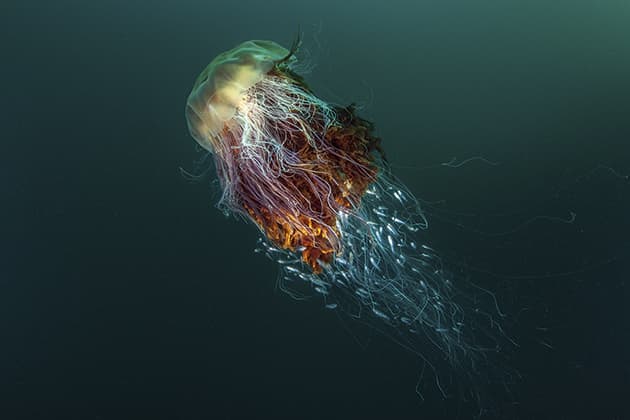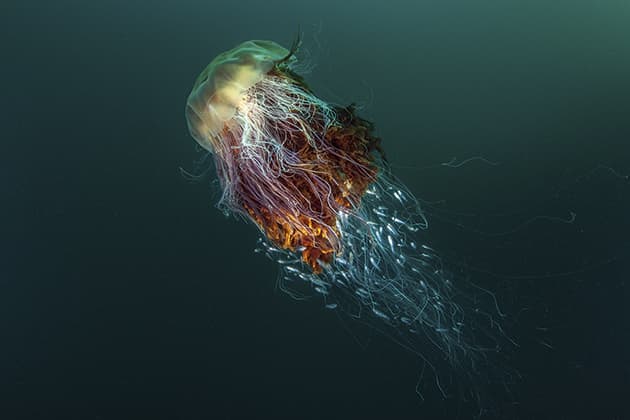Make sure you check out our gallery of our other favourite shots from the competition

‘Hitchhikers’ (Lion’s mane jellyfish, Cyanea capillata) off the Island of Hirta, Scotland. Photo by George Stoyle
Can you tell me about this image and where you took it? I read that it was a shot you came upon quite by chance.
Yes, I came upon it completely by chance, but then that’s often the way with underwater photography.
I was diving just off an island in the St Kilda archipelago off the north-west coast of Scotland. I was working with the Heriot Watt Scientific Dive Team surveying sea caves and rocky reefs as part of a Scottish Natural Heritage project, and I had just come to the end of a dive. I was swimming slowly back to the boat, away from the island, while undergoing my safety stop at around 5m and came face to face with the largest lion’s mane jellyfish I had ever seen.
Since I was using a fisheye lens, I had to get close in order to get the shot, aware of the jellyfish’s long, stinging tentacles. As I got closer, I saw all the juvenile fish that had taken refuge in its tentacles, something I hadn’t seen before.
Is underwater photography something you’re fairly well experienced in?
I’ve been involved in underwater photography for around 12 years. In the early 2000s I moved to North Wales and started working, initially part-time, in marine ecology and conservation. During my five or so years there, I dived fairly extensively around the coast.
It was the people I met and dived with around this time who really inspired me to take up underwater photography. In 2004 I bought my first underwater housing. And the next few years I spent working, travelling, photographing and diving initially going back to the southern hemisphere where I’d worked a few years earlier, and then working for some time in various parts of the Caribbean as a coral reef researcher.
How was this shot lit? Are these quite difficult conditions in which to shoot in terms of visibility? How did you overcome this with your camera settings?
Visibility is often the main issue when shooting underwater, particularly in the UK and particularly for wideangle shots such as this. On this occasion, however, we were diving in clear oceanic waters nearly 100 miles from the UK mainland and the jellyfish was huge, so the shot wasn’t particularly challenging.
Saying that, even in relatively clear water you have to be careful to avoid backscatter (light reflecting off particles in the water). I was shooting with a 15mm fisheye lens and, very often, if your strobes are positioned incorrectly, backscatter can cause problems when shooting this wide (you can see I didn’t avoid it altogether).
Also, the angle at which you shoot can make a big difference – most wideangle underwater shots work better if you shoot towards the surface.
What should be the aim of good wildlife photography?
For me, it’s showing the natural behaviour of an animal in its typical environment, with perhaps the potential to learn something new about a species through a catalogue of work built up over years of time spent in the field. There are exceptions, but I’m not really interested in baited photography or situations that have been over-engineered in order to produce a certain behaviour.
The most inspiring wildlife photographers to me are those who really get to know a subject and its environment, researching its biology and ecology; those who spend years in the field perfecting their craft – watching and waiting.
Although I have spent a fair amount of time in the field, I can’t really claim to be one of these photographers. I think they are quite a rare breed. I have great respect and admiration for them, and the sacrifices they make.
What are some of your favourite subjects to shoot, and why?
I don’t really have a favourite subject. I love to photograph all wildlife both above and below the water. I do, however, have a avourite time of day at which to shoot both wildlife and landscapes: just before and after sunrise.
The quality and the colour of light available at these times can be magical. Together with the long shadows and potential for backlighting, they can result in truly spectacular wildlife photography.
Very often these moments are so fleeting that it’s a very rewarding feeling to be one of the few people out and about to experience them.
What are some of your favourite photographic locations?
I love to shoot in the tropics, both above and below water. The quality of light and variety of colours are often perfect for photography.
However, I would have to say my favourite locations are right here in the UK. I live on the Yorkshire coast so, by default, this has become one of my favourite places to shoot, particularly at sunrise. But really, nowhere else in the UK quite compares to Scotland for both landscape and wildlife photography. If the weather is right, there aren’t many other places in the world I would rather be with my camera.
The diving, particularly on the west coast, is generally superb, and the scenery and natural beauty from the Western Isles to the Highlands all the way to the east coast is great.
What accessory do you always make sure you have with you?
From a tech perspective I guess my phone is something that I wouldn’t want to be without. For certain situations I’ve come to rely quite heavily on GPS and the internet, along with numerous apps.
From a practical perspective, when shooting above water I’d probably say my wellies are my most crucial bit of kit after my camera. I sounds a bit daft, but for a large part of the year it’s pretty much the only bit of kit I would really struggle without. To be able to stay out all day with dry feet is crucial. Saying that, though, I think a waterproof jacket, trousers, hat and gloves are just as important.
Which camera, lens and underwater housing do you use?
I use a Nikon D700 with a Sigma 15mm fisheye lens together with 2x Inon Z-240 strobes. It’s a relatively old set-up but still a very capable one, and stands out when compared with some of the very latest gear. The housing I use is made by Nauticam which, arguably, makes some of the best quality housings.
About George Stoyle
George is a landscape, wildlife and conservation photographer based in North Yorkshire. As a conservation photographer and marine ecologist, he is also involved in a number of international scientific research and conservation projects. To see more of his images, visit www.earthinfocus.com








